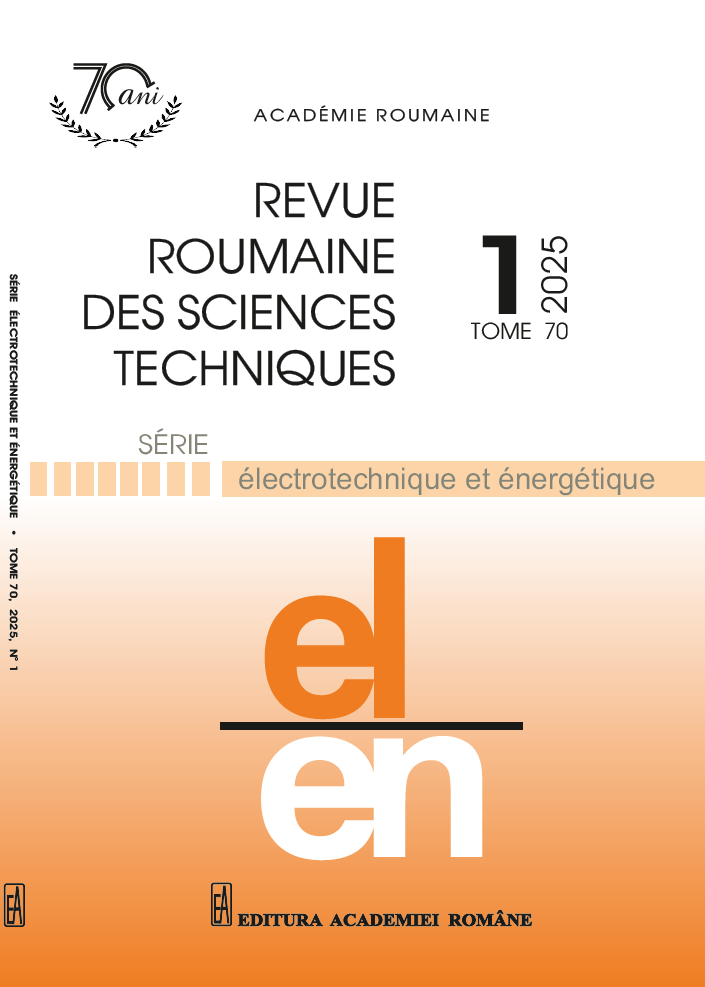CONTRÔLE DE TENSION BASÉ SUR L'IoT DANS UN RÉSEAU INTELLIGENT AVEC CONTRÔLE PRÉVENTIF DANS UN RÉGULATEUR DE TENSION AUTOMATIQUE
DOI :
https://doi.org/10.59277/RRST-EE.2025.1.13Mots-clés :
Réseau intelligent, Contrôle de tension, Internet des objets (IoT), Courant d'excitation d'un générateur, Régulateur de tension automatique, Condensateur shuntRésumé
La mise en œuvre d'un réseau intelligent intègre des technologies numériques modernes, notamment des systèmes de surveillance, des capacités de communication bidirectionnelle et des mécanismes de contrôle automatisés, afin d'améliorer l'efficacité globale du réseau. Maintenir la tension dans des plages spécifiées est une mission essentielle d'un gestionnaire de réseau de distribution. La tension d'un réseau intelligent dépend de la source de production, du type de charge électrique et de la distance de la ligne de transport. Cet article présente une nouvelle méthode de régulation de tension en temps réel d'un réseau intelligent utilisant l'Internet des objets (IoT). Cet article vise à améliorer la stabilité de la tension du système en surveillant les niveaux de tension à différents nœuds d'un réseau intelligent et en choisissant et en exploitant le mécanisme de correction approprié. Les mécanismes d'ajustement à mettre en œuvre consistent à faire varier dynamiquement le courant d'excitation des générateurs d'une centrale thermique et à faire fonctionner dynamiquement la batterie de condensateurs commutés et le réacteur, situés à différents endroits, grâce à l'IoT. Un contrôle prédictif est proposé dans le régulateur automatique de tension (AVR) côté générateur pour un contrôle efficace de la tension dans les réseaux intelligents avec un temps de réponse réduit en cas de problème. La charge de travail du gestionnaire de réseau de distribution pour le maintien de la tension du réseau peut être réduite.
Références
(1) J.O. Petintin, M. Shaaban, Voltage regulation in a smart distribution system incorporating variable renewable generation, IEEE Innovative Smart Grid Technologies-Asia, pp. 583–588 (2014).
(2) O. Homaee, A. Zakariazadeh, S. Jadid, Real-time voltage control algorithm with switched capacitors in the smart distribution system in the presence of renewable generations, International Journal of Electrical Power & Energy Systems, 54, pp. 187–197 (2014).
(3) L. Jiang, K. Smedley, Volt/VAR control with DERs, LTCs, and switched capacitors: case study with a commercial distribution system, IEEE Innovative Smart Grid Technologies-Asia, pp. 1330–1334 (2014).
(4) X.P. Zhang, A framework for operation and control of smart grids with distributed generation, Power and Energy Society General Meeting (2008).
(5) A.M. Sharaf, B. Khaki, A FACTS-based switched capacitor compensation scheme for smart grid applications, International Symposium on Innovations in Intelligent Systems and Applications, pp. 1–5 (2012).
(6) M. Kaur, S. Kalra, A review on IoT based smart grid, International Journal of Energy, Information and Communications, 7, 3, pp. 11–22 (2016).
(7) S.S.N. Kumar, S.K. Rao, M.S. Raju, S. Trimurthulu, K. Sivaji, T.R.M. Reddy, IoT-based control and monitoring of smart grid and power theft detection by locating area, International Research Journal of Engineering and Technology, 4, 7, pp. 1923–27 (2017).
(8) Y.W. Shahid, S. Sharma, Internet of Things (IoT) based smart grid, International Journal of Research, 7, 11, pp. 2113–24 (2018).
(9) S. Mugunthan, T. Vijayakumar, Review on IoT-based smart grid architecture implementations, Journal of Electrical Engineering and Automation, 1, 1, pp. 12–20 (2019).
(10) Y. Saleem, N. Crespi, M.H. Rehmani, R.L. Copeland, Internet of Things-aided smart grid: technologies, architectures, applications, prototypes, and future research directions, IEEE Access, 7, pp. 62962–63003 (2019).
(11) H. Shahinzadeh, J. Moradi, G.B. Gharehpetian, H. Nafisi, M. Abedi, IoT architecture for smart grids, International Conference on Protection and Automation of Power System (IPAPS) (2019).
(12) A. Ghasempour, Internet of Things in smart grid: architecture, applications, services, key technologies, and challenges, Inventions, 4, 1, 22 (2019).
(13) L. Tong, J. Zhou, J. Li, IoT-based low-voltage power distribution system management and control platform, Frontiers in Energy Research, 10 (2022).
(14) N.A. Hidayatullah, A.C. Kurniawan, A. Kalam, Power transmission and distribution monitoring using Internet of Things (IoT) for smart grid, IOP Conference Series: Materials Science and Engineering, 384 (2017).
(15) C. Babu, D.D. Kumar, K. Kumar, K.J. Reddy, Power monitoring and control system for medium voltage smart grid using IoT, IOP Conference Series, pp. 120–127 (2020).
(16) J. Pandia Rajan, S. Edward Rajan, C.K. Aravind, A. Sivaprakash, Smart grid security enhancement by detection and classification of non-technical losses employing deep learning algorithm, International Transactions on Electrical Energy Systems, 30, 9, pp. 1–12 (2020).
(17) S. Yang, X. Tong, J. Yin, H. Wang, Y. Deng, L. Liu, BPF-based grid voltage feed-forward control of grid-connected converters for improving robust stability, Journal of Power Electronics, 17, 2, pp. 432–441 (2017).
(18) A. Saleh, D. Ali, I. Reza, Model predictive control of distributed generations with feed-forward output currents, IEEE Transactions on Smart Grid, 10, 2, pp. 1488–1500 (2019).
(19) P. Kumar, Mohit K., N. Pal, An efficient control approach of voltage and frequency regulation in an autonomous microgrid, Rev. Roum. Sci. Techn. – Électrotechn. et Énerg., 66, 1, pp. 33–39 (2021).
(20) B. Hadmer, S. Drid, A. Kouzou, L. Chrifi-Alaoui, Voltage sensorless control of five-level packed U-Cell inverter based on Lyapunov approach for grid-connected photovoltaic system, Rev. Roum. Sci. Techn. – Électrotechn. et Énerg., 69, 2, pp. 135–140 (2024).
(21) P. Raghavendra, Nuvvula, S.S. Ramakrishna, Kumar, P. Polamarasetty, Gaonkar, N. Dattatraya, A. Sathoshakumar, Khan, Baseem, Voltage profile analysis in smart grids using online estimation algorithm, Journal of Electrical and Computer Engineering, pp. 1–9 (2022).
(22) R. Gupta, M. Paolone, Experimental validation of model-less robust voltage control using measurement-based estimated voltage sensitivity coefficients, IEEE Belgrade PowerTech, pp. 1-8 (2023).
(23) M. Golgol, A. Pal, High-speed voltage control in active distribution systems with smart inverter coordination and deep reinforcement learning, IEEE Power & Energy Society General Meeting, pp. 1–5 (2024).
(24) A. Soundarapandian, S. Muralidharan, Enhancing the transient performances and stability of AVR system with BFOA tuned PID controller, Journal of Control Engineering and Applied Informatics, 18, 1, pp. 20–29 (2016).
Téléchargements
Publiée
Numéro
Rubrique
Licence
(c) Copyright REVUE ROUMAINE DES SCIENCES TECHNIQUES — SÉRIE ÉLECTROTECHNIQUE ET ÉNERGÉTIQUE 2025

Ce travail est disponible sous licence Creative Commons Attribution - Pas d'Utilisation Commerciale - Pas de Modification 4.0 International.


